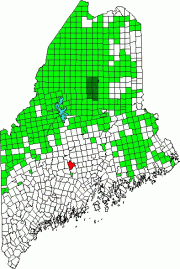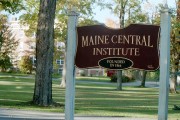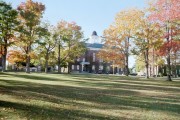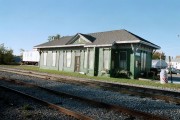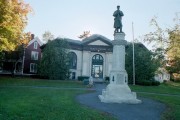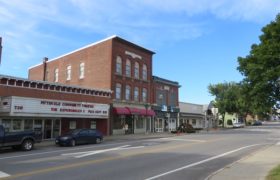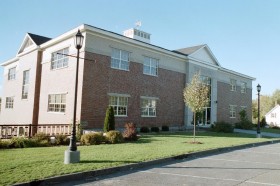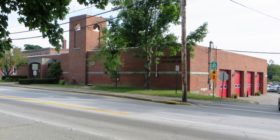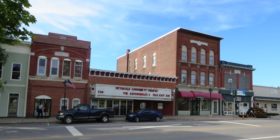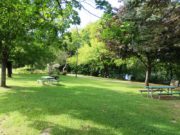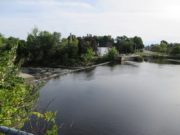![Pittsfield 1889 "Bird's Eye View" Looking Northwest with the Sebasticook River flowing North to South [Library of Congress] Pittsfield 1889 "Bird's Eye View" Looking Northwest with the Sebasticook River flowing North to South](https://maineanencyclopedia.com/wp-content/uploads/Pittsfield-Birdseye-View-jp2-Copy.jpg)
Pittsfield 1889 “Bird’s Eye View” Looking Northwest with the Sebasticook River flowing North to South
| Year | Population |
|---|---|
| 1970 | 4,274 |
| 1980 | 4,125 |
| 1990 | 4,190 |
| 2000 | 4,214 |
| 2010 | 4,215 |
| Geographic Data | |
|---|---|
| N. Latitude | 44:46:12 |
| W. Longitude | 69:26:05 |
| Maine House | District 106 |
| Maine Senate | District 3 |
| Congress | District 2 |
| Area sq. mi. | (total) 48.7 |
| Area sq. mi. | (land) 48.2 |
| Population/sq.mi. | (land) 87.5 |
County: Somerset
Total=land+water; Land=land only |
|
[PITS-field] a town in Somerset County, was incorporated as the town of Warsaw on June 19, 1819 from Plymouth Gore, Sebasticook and Warsaw. It has had historical relations with nearby towns:
In 1821 it set off land to Twenty Five Mile Pond Plantation (now Burnham).
1824 was an important year for the town as it set off land to Canaan, annexed land from Palmyra, and changed its name to Pittsfield in honor of William Pitts of Boston, a large landowner.
Moses Martin of Norridgewock came to the area in 1790 on a hunting expedition, admired the location, and became, along with his wife and four children, its first settler. A skilled woodsman, hunter, trapper, and fisher, he got along well with the local Indians.
By 1855 the railroad had arrived. The Penobscot and Kennebec Railroad, with tracks from Bangor to Waterville and connections south merged in 1862 with the Androscoggin and Kennebec creating the Maine Central Railroad.
As did many Maine communities, Pittsfield’s woolen mills provided steady employment during the first half of the 20th century, then literally “went South,” finding cheaper labor in the 1950’s.
Two sons of Pittsfield became governors of Maine: Llewellyn Powers (1897-1901) and Carl E. Milliken (1917-1921). Hugh Pendexter, a poet and novelist, was also born here. It is also the birthplace of Nathaniel M. Haskell, a U.S. Representative.
Maine Central Institute, founded in 1866 as a preparatory school for Bates College, is one of the “Big 10” private secondary schools in Maine that still serves the public school population as well.
Downtown Pittsfield, on the Sebasticook River, was wiped out by a “Great Fire” in 1881 and rebuilt immediately. It was hit by major floods in 1887, 1896, 1901, 1936, and the “Great Flood” of 1987. The town is at the junction of Maine Routes 11,69, 100 and 152. Interstate 95 passes on the outskirts.
Form of Government: Council-Mayor-Manager.
Additional resources
Image credit: “Pittsfield Birdseye View 1889.” LC classification: G3734.P56A3 1889 .N6. Repository: Library of Congress Geography and Map Division Washington, D.C. 20540-4650 USA dcu. Digital ID: G3734P Pm002480 Http://Hdl.Loc.Gov/Loc.Gmd/G3734P.Pm002480. Image source: http://www.loc.gov/item/75693247 (accessed March 18, 2013)
Chatto, Clarence I. History of Pittsfield. Auburn, Me. Chatto and Turner. 1911.
Cook, Sanger Mills. Pittsfield on the Sebasticook. Furbush-Roberts Printing Company, Inc. 1966.
Gulick, Peter Lee. The Woolen Industry of Pittsfield. 1969. (Thesis (M.A.) — University of Maine at Orono) [University of Maine. Raymond H. Fogler Library. Special Collection]
*Maine. Historic Preservation Commission. Augusta, Me. Text and photos from National Register of Historic Places: http://pdfhost.focus.nps.gov/docs/nrhp/text/xxxxxxxx.PDF and http://pdfhost.focus.nps.gov/docs/nrhp/photos/xxxxxxxx.PDF
Founders Hall: https://npgallery.nps.gov/pdfhost/docs/NRHP/Text/79000167.pdf
Pittsfield Publkic Library: https://npgallery.nps.gov/pdfhost/docs/NRHP/Text/83000471.pdf
Pittsfield Railroad Station: https://npgallery.nps.gov/pdfhost/docs/NRHP/Text/80000254.pdf
Pittsfield Universalist Church: https://npgallery.nps.gov/pdfhost/docs/NRHP/Text/83000472.pdf
Pittsfield Sesquicentennial, 1819-1969. Pittsfield, Me. 1969.
National Register of Historic Places – Listings
Founders Hall
[South Main Street] Founders Hall, on the campus of the Maine Central Institute, is significant both in its architecture and importance as an educational institution. The school was chartered as a private academy on February 1, 1866 and opened to students August 30, 1866. The cornerstone was laid in 1868 and by 1870 the lower floor had been completed. Donations finished the structure and in 1877 the final touch was added, a bell from the town. The structure has remained the focal point of the campus. Architecturally, this building is an excellent example of mid-19th century Maine academic architecture. The building still dominates the campus despite the addition of many more modern buildings. Maine Central Institute has long provided high quality secondary education for this large inland rural area.* [See photos above.]
Pittsfield Public Library
[Main Street] The Library is one of Maine’s most distinctive Carnegie libraries and one of the earliest and finest examples of a Beaux Arts building in central Maine. Designed in 1903 by Albert Randolph Ross of New York, the library is among the most notable of Pittsfield’s buildings from any period. It was gift to the town by Andrew Carnegie and the entrepreneur Robert Dodson, founder of the Pittsfield woolen industry. Dodson resembled Carnegie as a Scottish immigrant who rose to captain an American industry. Pittsfield citizens chose the present location because proximity to the Maine Central Railroad station and tracks. They wanted the library to be conspicuous to train passengers.* [See photo above.]
Pittsfield Railroad Station
[Central Street] On July 2, 1855, the Maine Central Railroad opened a line with regular schedules connecting Pittsfield, Bangor, and Waterville. It transformed this small village into a bustling and rapidly growing community. In 1886, the Sebasticook and Moosehead Railroad built a line connecting Pittsfield and Hartland. Pittsfield had now become an important railroad junction. A new passenger station was erected in 1888 by the Maine Central Railroad. A small exchange house for interchange of freight between the two railroads was built, new platforms were laid. The design was in keeping with the prevailing trend in railroad architecture, combining Italianate features with Stick Style elements. This station as restored by the Athenaeum Club of Pittsfield is an exceptionally well preserved example of a rapidly disappearing type of public facility.* [See photo above.]
Pittsfield Universalist Church
[North Main and Easy Streets] The 1899 First Universalist Church is Pittsfield’s principal historic meetinghouse, and perhaps the best local example of the Queen Anne style. The unique interior remains perfectly preserved. The building contains an uncommon amount of stained-glass for a small town church.Most important is the artwork of the sanctuary. On the ceiling are eleven small frescoes by the noted Maine artist Henry H. Cochrane (1860-1946). The Pittsfield frescoes are among Cochrane’s finest and most ambitious works. The stained-glass windows of the sanctuary are also impressive.* [See photo above.]


